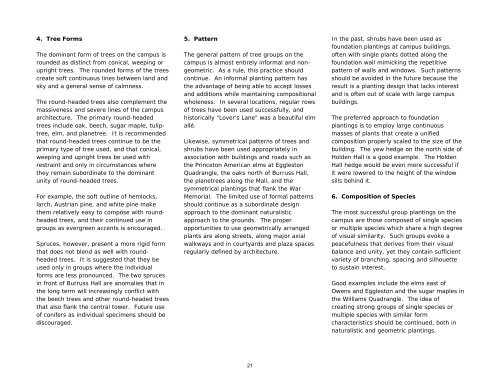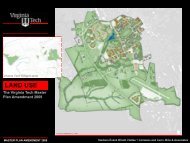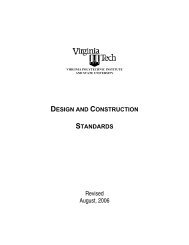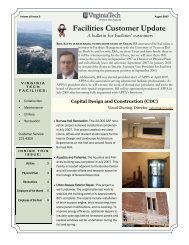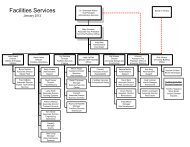Campus Design Principles - Facilities Services - Virginia Tech
Campus Design Principles - Facilities Services - Virginia Tech
Campus Design Principles - Facilities Services - Virginia Tech
Create successful ePaper yourself
Turn your PDF publications into a flip-book with our unique Google optimized e-Paper software.
4. Tree Forms<br />
The dominant form of trees on the campus is<br />
rounded as distinct from conical, weeping or<br />
upright trees. The rounded forms of the trees<br />
create soft continuous lines between land and<br />
sky and a general sense of calmness.<br />
The round-headed trees also complement the<br />
massiveness and severe lines of the campus<br />
architecture. The primary round-headed<br />
trees include oak, beech, sugar maple, tuliptree,<br />
elm, and planetree. It is recommended<br />
that round-headed trees continue to be the<br />
primary type of tree used, and that conical,<br />
weeping and upright trees be used with<br />
restraint and only in circumstances where<br />
they remain subordinate to the dominant<br />
unity of round-headed trees.<br />
For example, the soft outline of hemlocks,<br />
larch, Austrian pine, and white pine make<br />
them relatively easy to compose with roundheaded<br />
trees, and their continued use in<br />
groups as evergreen accents is encouraged.<br />
Spruces, however, present a more rigid form<br />
that does not blend as well with roundheaded<br />
trees. It is suggested that they be<br />
used only in groups where the individual<br />
forms are less pronounced. The two spruces<br />
in front of Burruss Hall are anomalies that in<br />
the long term will increasingly conflict with<br />
the beech trees and other round-headed trees<br />
that also flank the central tower. Future use<br />
of conifers as individual specimens should be<br />
discouraged.<br />
5. Pattern<br />
The general pattern of tree groups on the<br />
campus is almost entirely informal and nongeometric.<br />
As a rule, this practice should<br />
continue. An informal planting pattern has<br />
the advantage of being able to accept losses<br />
and additions while maintaining compositional<br />
wholeness. In several locations, regular rows<br />
of trees have been used successfully, and<br />
historically “Lover’s Lane” was a beautiful elm<br />
allé.<br />
Likewise, symmetrical patterns of trees and<br />
shrubs have been used appropriately in<br />
association with buildings and roads such as<br />
the Princeton American elms at Eggleston<br />
Quadrangle, the oaks north of Burruss Hall,<br />
the planetrees along the Mall, and the<br />
symmetrical plantings that flank the War<br />
Memorial. The limited use of formal patterns<br />
should continue as a subordinate design<br />
approach to the dominant naturalistic<br />
approach to the grounds. The proper<br />
opportunities to use geometrically arranged<br />
plants are along streets, along major axial<br />
walkways and in courtyards and plaza spaces<br />
regularly defined by architecture.<br />
In the past, shrubs have been used as<br />
foundation plantings at campus buildings,<br />
often with single plants dotted along the<br />
foundation wall mimicking the repetitive<br />
pattern of walls and windows. Such patterns<br />
should be avoided in the future because the<br />
result is a planting design that lacks interest<br />
and is often out of scale with large campus<br />
buildings.<br />
The preferred approach to foundation<br />
plantings is to employ large continuous<br />
masses of plants that create a unified<br />
composition properly scaled to the size of the<br />
building. The yew hedge on the north side of<br />
Holden Hall is a good example. The Holden<br />
Hall hedge would be even more successful if<br />
it were lowered to the height of the window<br />
sills behind it.<br />
6. Composition of Species<br />
The most successful group plantings on the<br />
campus are those composed of single species<br />
or multiple species which share a high degree<br />
of visual similarity. Such groups evoke a<br />
peacefulness that derives from their visual<br />
balance and unity, yet they contain sufficient<br />
variety of branching, spacing and silhouette<br />
to sustain interest.<br />
Good examples include the elms east of<br />
Owens and Eggleston and the sugar maples in<br />
the Williams Quadrangle. The idea of<br />
creating strong groups of single species or<br />
multiple species with similar form<br />
characteristics should be continued, both in<br />
naturalistic and geometric plantings.<br />
21


